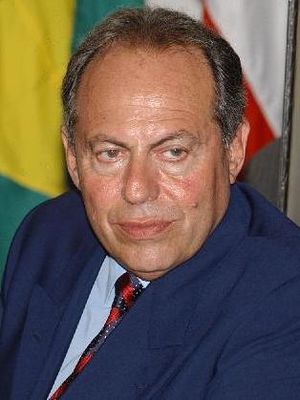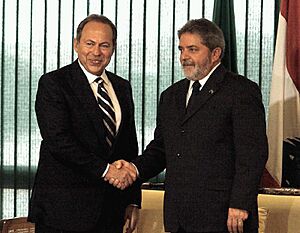Émile Lahoud facts for kids
Quick facts for kids
Émile Lahoud
|
|
|---|---|
|
إميل لحود
|
|

Lahoud in 2004
|
|
| 11th President of Lebanon | |
| In office 24 November 1998 – 24 November 2007 |
|
| Prime Minister | Rafic Hariri Selim Hoss Rafic Hariri Omar Karami Najib Mikati Fouad Siniora |
| Preceded by | Elias Hrawi |
| Succeeded by | Michel Suleiman |
| 11th Commander of the Lebanese Armed Forces | |
| In office 28 November 1989 – 23 November 1998 |
|
| Preceded by | Michel Aoun |
| Succeeded by | Michel Suleiman |
| Personal details | |
| Born | 12 January 1936 Baabdat, French Lebanon |
| Political party | Independent |
| Spouse |
Andrée Amadouni
(m. 1967) |
| Alma mater | Britannia Royal Naval College Naval War College |
| Awards | OM, ONC |
| Religion | Maronite |
| Military service | |
| Allegiance | |
| Branch/service | Lebanese Navy Lebanese Army |
| Years of service | 1956–1980 (Navy) 1980–1998 (Army) |
| Rank | General |
| Commands | Commander of the Lebanese Armed Forces |
| Battles/wars | Lebanese Civil War |
Émile Jamil Lahoud (born 12 January 1936) was an important Lebanese politician. He served as the 11th president of Lebanon from 1998 to 2007. During his time as president, the Israeli occupation of Southern Lebanon ended in May 2000. This occupation had been going on since 1982.
Lahoud worked to make the Lebanese army stronger. He also tried to reduce sectarianism, which is when people are divided by their religious groups. He was a close friend of Syrian president Bashar al-Assad. Lahoud was seen as important in keeping the Syrian occupation of Lebanon in place.
Contents
Early Life and Family
Émile Lahoud was born on 12 January 1936. His family's hometown is Baabdat, but the Armed Forces list his birthplace as Beirut. He is the youngest son of General Jamil Lahoud, who was also a government minister.
His mother, Andrenee Bajakian, was of Armenian background. Her family came from the Armenian village of Kesab in Syria. Émile Lahoud's older brother, Nasri Lahoud, was a judge. His uncle, Salim Lahoud, served as Lebanon's foreign minister from 1955 to 1957.
Lahoud's great-grandparents on his mother's side were from a place called Adabazar in the Ottoman Empire. This area is now part of Turkey. Sadly, his great-grandparents were among the many victims during the Armenian genocide that happened during World War I.
In 2001, Lahoud visited Armenia. During his trip, he went to Tsitsernakaberd. This is a special memorial complex for the victims of the Armenian Genocide. He placed a wreath there to honor their memory.
Education and Military Training
Émile Lahoud went to elementary school at the Collège de la Sagesse in Beirut. He then attended Brummana High School for his secondary education.
In 1956, he joined the Lebanese Army Naval Academy as a naval cadet. He continued his studies at Dartmouth Naval College in the United Kingdom. After returning to the Lebanese military academy, he graduated as an ensign.
Later, in 1986, he took a navy engineering course in the United Kingdom. As a captain, he also studied at the U.S. Naval War College in Newport, Rhode Island, graduating in 1973.
Military Career
Lahoud moved up through the ranks in the military. He became a lieutenant junior grade in 1962 and a lieutenant in 1969. He was promoted to lieutenant commander in 1974 and commander in 1976.
He became a Navy Engineer Staff Captain in 1980 and a Navy Engineer Staff Rear Admiral in 1985. In 1989, he was promoted to Major Lieutenant General.
Even though he trained as a naval officer, Lahoud was given important roles in the army. In 1970, he led the transportation section of the army's fourth division. In 1980, he became the Director of Personnel in the Army Command. He also worked at the Defense Ministry in 1983.
In 1989, Lahoud was chosen to be the Commander in Chief of the army. This was part of the government supported by Western and Arab countries. During his time as army chief, Lahoud allowed Syria to have strong control over Lebanon's security and military.
Political Career
Lahoud decided to run for president in 1998. The constitution was changed to allow the army commander-in-chief to become president. Many believed Syria supported this change. He won the presidency with 118 votes out of 128 in the Lebanese Parliament.
When he became president, he worked closely with Hezbollah. He also chose Selim al-Hoss as his prime minister. This caused some tension with Rafiq Hariri, another important politician. Lahoud also asked Syria to remove Ghazi Kanaan, who was Syria's intelligence chief in Lebanon, but his request was not granted.
During his presidency, Lahoud had a lot of control over government decisions. In 2001, he changed some rules about the president's power. He also ordered security forces to arrest people who disagreed with the government without telling other ministers.

Lahoud's six-year presidential term was supposed to end in 2004. However, Syria wanted him to stay for three more years. They saw him as important for their control over Lebanon. To do this, the constitution had to be changed again. It was said that Syria pressured politicians like Hariri to agree to this change.
This idea of extending Lahoud's term caused a lot of problems in Lebanon. In the end, Hariri and most of the parliament voted to extend Lahoud's term until November 2007. However, four government ministers resigned in protest.
Both the Iranian government and Hezbollah were happy about the extension. The Iranian President congratulated Lahoud, and Hezbollah leaders also visited him. Many saw this extension as a clear sign of Syria's influence in Lebanese politics.
In an interview in 2006, Lahoud said that Hezbollah was respected in Lebanon because it "freed our country." He also said that even though Hezbollah was a small group, it stood up to Israel. He showed great respect for Hezbollah leader Hassan Nasrallah.
Lahoud's presidential term ended in 2007. A new president was not chosen right away. After six months of political disagreement, the Lebanese parliament finally elected former army chief Michel Suleiman as president.
Some people said that Lahoud spent a lot of his presidency swimming and sunbathing. Even though he had support from his Christian Maronite community and the military, some saw him as a weak leader. This was mainly because he often followed Syria's lead. A Druze leader, Walid Jumblatt, even called Lahoud a "helpless ghost."
Personal Life
Émile Lahoud married Andrée Amadouni in 1967. They have three children together. Their children are Karine (born 1969), Emile Jr. (born 1975), and Ralph (born 1977). Karine was previously married to Elias Murr.
A book called Years of Resistance: The Mandate of Emile Lahood, the Former President of Lebanon was published in May 2012. It was written by Karim Pakradouni. The book talks about Lahoud's political life and his impact on Lebanon's history.
Honors and Awards
Émile Lahoud received many awards and honors during his career, both from Lebanon and other countries.
National Honors (Lebanon)
- The Medal of 31 December 1961
- Order of Merit (3rd Grade) (1971)
- Navy Medal (Excellent Grade) (1974)
- Order of Merit (2nd Grade) (1983)
- National Order of the Cedar (Knight) (1983)
- Order of Merit (1st Grade) (1988)
- National Order of the Cedar (Officer) (1989)
- War Medal, 1991 War Medal (1992)
- National Order of the Cedar (Grand Cordon) (1993)
- Medal of the "Dawn of the South" (1993)
- The Medal of National Unity (1993)
- Military Valor Medal (1994)
- State Security Medal (1994)
- Order of Merit (Extraordinary Grade) (1998)
Foreign Honors (Other Countries)
 Haiti : Medal of Merit and Honor (High Ranking Officer) (1974)
Haiti : Medal of Merit and Honor (High Ranking Officer) (1974) Romania : Tudor Vladimirescu Medal (4th degree) (1974), The "Star of Romania" Collar (2001)
Romania : Tudor Vladimirescu Medal (4th degree) (1974), The "Star of Romania" Collar (2001) France : Commander of the Legion of Honor (1996), Grand Cross of the Legion of Honor (2001)
France : Commander of the Legion of Honor (1996), Grand Cross of the Legion of Honor (2001) Italy : Order of Merit (Senior Officer Rank) (1997)
Italy : Order of Merit (Senior Officer Rank) (1997) Argentina : Great Cross of Argentina (1998)
Argentina : Great Cross of Argentina (1998) Jordan : Order of Al-Hussein bin Ali (1999)
Jordan : Order of Al-Hussein bin Ali (1999) Qatar : Great Collar of Independence (1999)
Qatar : Great Collar of Independence (1999) Armenia : Order of St. Mesrop Mashtots (2000)
Armenia : Order of St. Mesrop Mashtots (2000) Saudi Arabia : Order of King Abdulaziz (2000)
Saudi Arabia : Order of King Abdulaziz (2000) United Arab Emirates : Great Collar of The Union (2000)
United Arab Emirates : Great Collar of The Union (2000) Kuwait : Great Collar of Mubarak (2000)
Kuwait : Great Collar of Mubarak (2000) Egypt : Great Collar of the Nile (2000)
Egypt : Great Collar of the Nile (2000) Bahrain : Collar of the Order of Khalifa (2000)
Bahrain : Collar of the Order of Khalifa (2000) Slovakia : Order of the White Double Cross (1st Class) (2001)
Slovakia : Order of the White Double Cross (1st Class) (2001) Morocco : Order of Muhammad (Extraordinary Grade) (2001)
Morocco : Order of Muhammad (Extraordinary Grade) (2001) Tunisia : Order of November the 7th (highest Grade) (2001)
Tunisia : Order of November the 7th (highest Grade) (2001) Monaco : Grand Cross of the Order of Grimaldi (13 July 2001)
Monaco : Grand Cross of the Order of Grimaldi (13 July 2001) Greece : Grand Cross of the Order of the Redeemer (2001)
Greece : Grand Cross of the Order of the Redeemer (2001) Syria : Order of the Umayyads – Grand Cordon (2002)
Syria : Order of the Umayyads – Grand Cordon (2002) Ukraine : Badge of the Order of Prince Yaroslav the Wise – 1st class (2002)
Ukraine : Badge of the Order of Prince Yaroslav the Wise – 1st class (2002) Cyprus : Grand Collar of the Order of Makarios III (2002)
Cyprus : Grand Collar of the Order of Makarios III (2002) Algeria : Order of the Athir (23 July 2002)
Algeria : Order of the Athir (23 July 2002) Yemen : Order of the Republic (2002)
Yemen : Order of the Republic (2002) Oman : Military Order of Oman – first category (2002)
Oman : Military Order of Oman – first category (2002) Bulgaria : The Order Stara Planina (2003)
Bulgaria : The Order Stara Planina (2003)- Gold Olympic Order (2003)
 Brazil : National Order of the Southern Cross, Brasilia (2004), Big Cross of the Ipiranga Order, São Paulo (2004)
Brazil : National Order of the Southern Cross, Brasilia (2004), Big Cross of the Ipiranga Order, São Paulo (2004) Hungary : Order of Merit – Grand Cross with Chain (2004)
Hungary : Order of Merit – Grand Cross with Chain (2004)- Knight Grand Cross of Merit with Gold Star of the Sacred Military Constantinian Order of Saint George (2004), Knight Grand Cross of Merit with Gold Plate of the Sacred Military Constantinian Order of Saint George (2005)
 Poland : Grand Cross of the Order of Merit (2004)
Poland : Grand Cross of the Order of Merit (2004)- Order of the Federation – 1st Class (Cordon), Arab Military Sports Federation (2005)
See also
 In Spanish: Émile Lahoud para niños
In Spanish: Émile Lahoud para niños

